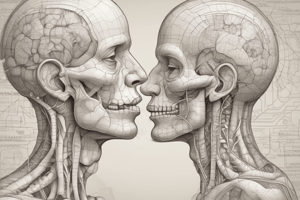Podcast
Questions and Answers
What is the primary function of the olfactory receptors in the nose?
What is the primary function of the olfactory receptors in the nose?
- To filter and warm incoming air
- To detect airborne molecules for smell (correct)
- To trap dust and pathogens
- To facilitate airflow to the lungs
What structural components make up the external structure of the nose?
What structural components make up the external structure of the nose?
- Bone and cartilage (correct)
- Tissue and epithelium
- Cartilage and muscle
- Skin and fat
Which of the following is a common condition affecting the nasal mucosa?
Which of the following is a common condition affecting the nasal mucosa?
- Asthma
- Pneumonia
- Rhinitis (correct)
- Bronchitis
What is the purpose of cilia in the nasal cavity?
What is the purpose of cilia in the nasal cavity?
What is one recommended method to maintain nasal hygiene?
What is one recommended method to maintain nasal hygiene?
Flashcards are hidden until you start studying
Study Notes
Anatomy of the Nose
-
External Structure:
- Made up of bone and cartilage.
- Includes the bridge, tip, and nostrils (nares).
-
Internal Structure:
- Nasal cavity divided into right and left halves.
- Lined with mucous membranes containing olfactory epithelium for smell.
Functions of the Nose
-
Respiration:
- Filters, warms, and humidifies incoming air.
- Acts as the entry point for airflow to the respiratory tract.
-
Olfaction:
- Contains olfactory receptors that detect airborne molecules.
- Sends signals to the brain for identification of smells.
-
Protection:
- Mucous traps dust, pathogens, and other particles.
- Cilia move trapped particles out of the nasal cavity.
Common Conditions
-
Rhinitis:
- Inflammation of the nasal mucosa.
- Can be allergic or non-allergic.
-
Sinusitis:
- Inflammation of the sinuses, often accompanying nasal congestion.
- Symptoms include facial pain, pressure, and nasal discharge.
-
Nasal Polyps:
- Noncancerous growths on the nasal lining.
- Can cause blockages and impaired sense of smell.
Diagnosis and Treatment
-
Diagnosis:
- Physical examination, nasal endoscopy, allergy tests, imaging (CT scans).
-
Treatment Options:
- Medications: Antihistamines, decongestants, nasal corticosteroids.
- Surgery for structural issues or persistent polyps and sinusitis.
Hygiene and Care
-
Nasal Hygiene:
- Saline nasal sprays can help keep nasal passages moist.
- Regular cleaning to prevent irritation from allergens or pollutants.
-
Avoiding Irritants:
- Limiting exposure to smoke, strong odors, and allergens.
- Using air purifiers in living environments can improve air quality.
External Nose Structure
- Composed of bone and cartilage
- Features include the bridge, tip, and nostrils (nares)
Internal Nose Structure
- Nasal cavity divided into right and left halves
- Lined with mucous membranes containing olfactory epithelium that allows for smell
Functions of the Nose
- Respiration:
- Filters, warms, and humidifies incoming air
- Serves as the entry point for airflow to the respiratory tract
- Olfaction:
- Contains olfactory receptors for detecting airborne molecules
- Sends signals to the brain, enabling smell identification
- Protection:
- Mucus traps dust, pathogens, and other particles
- Cilia move trapped particles out of the nasal cavity
Common Nose Conditions
- Rhinitis:
- Inflammation of the nasal mucosa
- Can be caused by allergens or non-allergic factors
- Sinusitis:
- Inflammation of the sinuses, often accompanying nasal congestion
- Symptoms include facial pain, pressure, and nasal discharge
- Nasal Polyps:
- Noncancerous growths on the nasal lining
- Can cause blockages and impaired sense of smell
Nose Diagnosis and Treatment
- Diagnosis:
- Physical examination, nasal endoscopy, allergy tests, imaging (CT scans)
- Treatment Options:
- Medications: Antihistamines, decongestants, nasal corticosteroids
- Surgery for structural issues, persistent polyps, and sinusitis
Nose Hygiene and Care
- Nasal Hygiene:
- Saline nasal sprays help keep nasal passages moist
- Regular cleaning prevents irritation from allergens or pollutants
- Avoiding Irritants:
- Limiting exposure to smoke, strong odors, and allergens
- Using air purifiers in living environments improves air quality
Studying That Suits You
Use AI to generate personalized quizzes and flashcards to suit your learning preferences.




